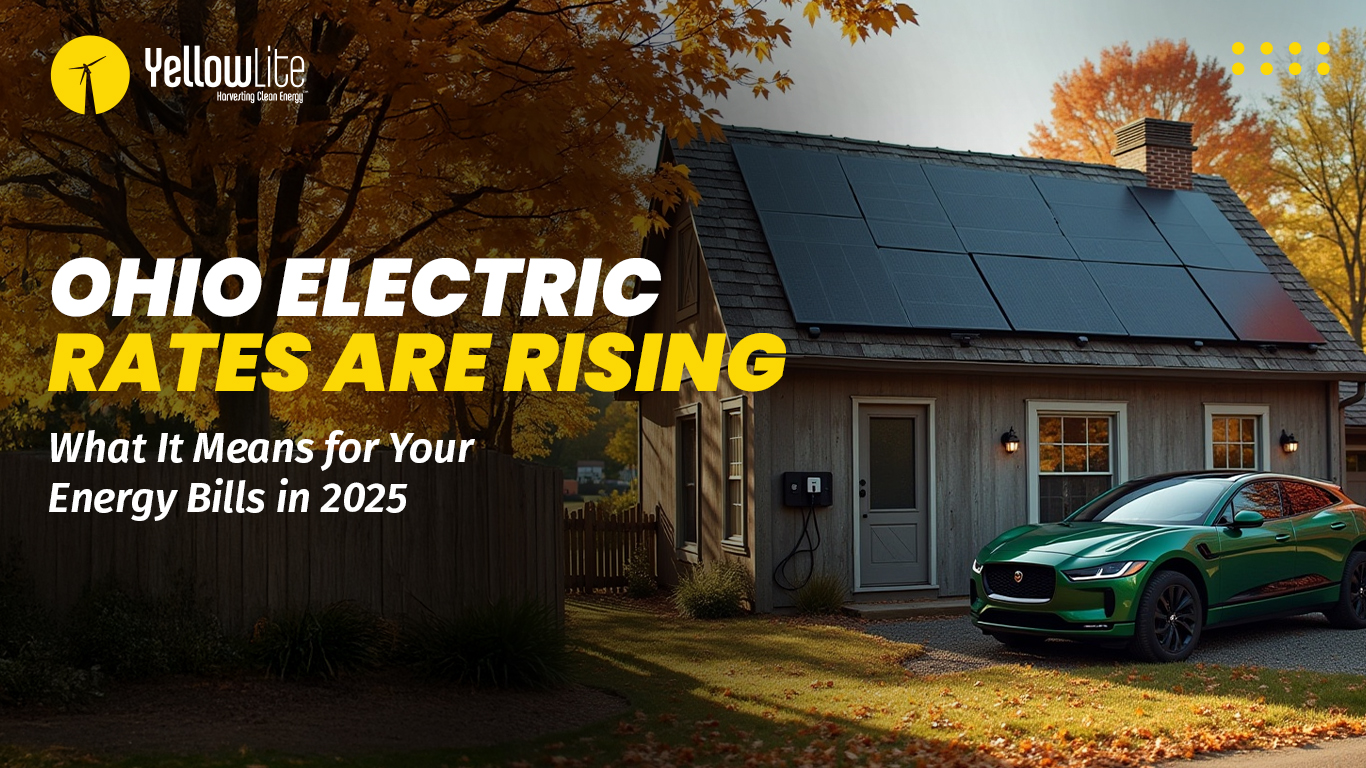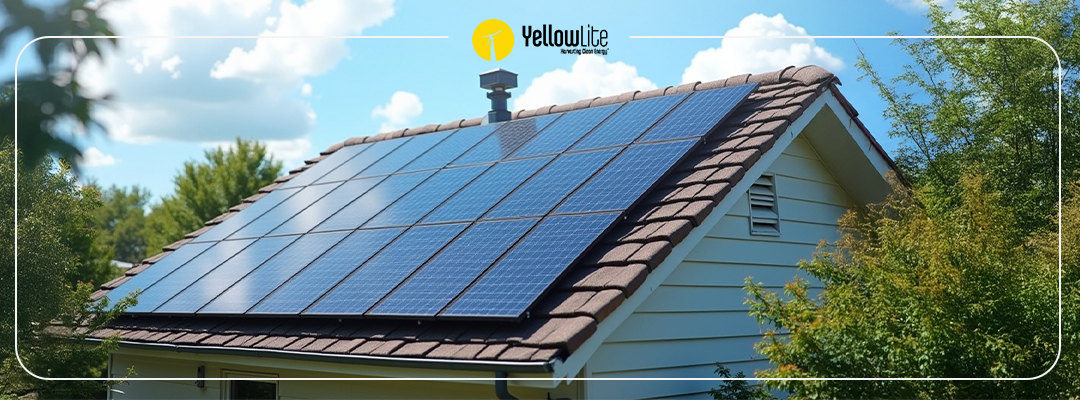Tired of your rising energy bills every month? You're wondering about solar power, but the whole cost thing can seem confusing, right?
Figuring out home solar panel costs can feel like decoding a secret language with confusing numbers and hidden fees that leave you scratching your head. Don't worry – we've got you covered.
In this comprehensive guide, we're going to break down home solar panels' average cost in 2025 and what that means for you.
How Do Home Solar Panels Work?
Home solar panels are designed to harness the sun's energy and convert it into electricity, helping homeowners in the Mid-West and Great Lakes and nearby regions lower their energy bills. These systems use photovoltaic (PV) cells to absorb sunlight and generate direct current (DC) power. An inverter then converts this DC power into alternating current (AC), which is what your home appliances use.
With ample sunshine, solar panels for your home can be a reliable and cost-effective energy solution. Plus, modern panels are designed to withstand various weather conditions, ensuring steady performance all year round. If you're looking to cut costs and switch to clean energy, investing in solar energy for your home is a smart investment in 2025.
What Affects the Average Cost of Home Solar Panels?
Investing in home solar panels is beneficial for many homeowners in the Mid-West and Great Lakes, but understanding what drives the costs is essential. The overall price of a solar installation is influenced by system size, energy output, quality of components, installation practices, and regional market dynamics.
These factors play an even more significant role in such areas, where sunlight levels and weather patterns vary throughout the year. As you plan your solar journey, being informed about these elements will help you make a confident decision.
System Size and Energy Output
The bigger the system, the more electricity it produces. If your household has high energy needs, a larger solar system can maximize savings. With changing seasons, choosing the right system size ensures consistent energy production year-round. The right setup will even allow you to generate surplus power, further lowering your electricity costs.
Home solar panels' average cost by system size
- 7 kW: $18,035 before incentives, $12,624 after incentives
- 8 kW: $20,611 before incentives, $14,428 after incentives
- 9 kW: $23,187 before incentives, $16,231 after incentives
- 10 kW: $25,764 before incentives, $18,035 after incentives
Factors Influencing Solar Panel for Home Price

The solar panel for home price depends on:
- Panel Efficiency – High-efficiency panels cost more but generate more power.
- Installation Complexity – Roof type, mounting systems, and labor affect pricing.
- Incentives & Rebates – Solar incentives lower the upfront costs of the system installation.
To know how much energy is required for your home, check out YellowLite's energy storage calculator.
Quality of Components and Installation
The home solar panels average cost is heavily influenced by the quality of materials and installation. High-efficiency solar panels, durable inverters, and premium mounting systems not only enhance performance but also reduce long-term maintenance. Choosing high-quality components ensures better energy output and reliability, leading to greater savings over time.
Equally important is expert installation. At YellowLite, our professional installers strategically position your solar panels to maximize sunlight capture, minimize shading, and withstand changing weather conditions. Proper installation means optimized energy production and a system built to last.
Regional Variations in Solar Panel Costs
The solar panel for home price isn't just about equipment, it's also affected by local incentives like net metering policies, and energy consumption trends. For example, in Ohio, homeowners benefit from solar tax credits, rebates, and net metering programs, which significantly offset upfront costs.
Seasonal variations also play a role, as optimizing your system for longer summer days and shorter winter days ensures maximum energy generation throughout the year. By tailoring your system to local conditions, you can maximize efficiency and financial returns.
Technological Advances Impact Solar Energy Costs
Advancements in solar technology continue to reduce the solar panels for your home price while increasing efficiency. Modern photovoltaic cells, high-performance inverters, and smart energy storage solutions make solar systems more cost-effective and productive.
By 2025, ongoing innovations are expected to further lower solar energy for home prices, making solar an even more attractive and accessible option for homeowners. With improved affordability and long-term savings, there's never been a better time to switch to solar.
2025 Cost Breakdown: Home Solar Panels Average Cost Analysis
Looking ahead to 2025, the home solar panels’ average cost includes several key components: solar panels, inverters, mounting hardware, installation labor, and necessary permits. While national averages offer a general benchmark, local factors such as competitive installer pricing and site-specific conditions play a major role in determining actual costs.
Although the upfront investment may seem significant, the long-term savings on energy bills and a potential increase in property value make solar a smart financial decision. By installing a system tailored to your home's energy needs, you can maximize both efficiency and cost-effectiveness.
2025 Home Solar Panels Average Cost Breakdown
Below is a projected cost breakdown for home solar panels average cost in 2025. These estimates provide a general overview of how installation costs are distributed, factoring in local pricing trends in the Mid-West and Great Lakes. Understanding these costs helps homeowners make informed decisions about their investment in solar energy for home price.

Home Solar Panels Average Cost vs. Historical Trends
The solar panel for home price has steadily declined over the past decade, thanks to technological advancements, increased production efficiency, and growing competition. Early adopters faced higher costs and longer payback periods, but with today's improved solar technology, the payback period has shortened significantly.
Solar energy for home price in 2025 is expected to remain competitive, continuing the trend of increased affordability and higher returns on investment. With better financing options and government incentives, going solar is now more accessible than ever.
Financing Options for Solar Panels
The solar panels for your home price doesn't have to be a barrier. Several financing options make solar energy more affordable, including solar loans, power purchase agreements (PPAs), and leasing programs. Many financial institutions offer low-interest loans specifically for renewable energy projects.
YellowLite also provides a zero-down solar financing option, allowing homeowners to install a high-quality solar system without any upfront costs. This means you can start saving on energy bills immediately while making affordable monthly payments toward your system.
Government Incentives and Tax Credits for Solar Panels
Homeowners can take advantage of several government programs designed to reduce the home solar panels average cost. The federal solar tax credit (ITC) provides a significant deduction on installation costs, and state-specific programs may offer rebates and incentives that further reduce your out-of-pocket expenses.
By leveraging these financial benefits, homeowners can shorten the payback period and maximize their return on investment. With lower installation costs, tax incentives, and long-term savings, switching to solar in 2025 is a smart and sustainable choice.
Leasing vs. Buying: What's Right for You?
Deciding between leasing and buying your solar system is a key step in your solar journey. Purchasing your system outright or through financing offers the highest long-term savings, increases property value, and lets you benefit from incentives that lower the home solar panels average cost.
Leasing provides a low-cost entry into solar with little to no upfront payment and minimal maintenance responsibilities. While this can be appealing, it may not offer the same financial benefits as ownership, such as tax credits or a higher resale value.
For homeowners in the Mid-West and Great Lakes, the right choice depends on your financial situation, long-term energy goals, and budget. Whether you prioritize immediate savings or long-term return on investment, YellowLite's experts can help you determine the best fit for your needs.
Why Choose YellowLite?
At YellowLite, we bring years of expertise in designing and installing high-quality solar systems tailored to your home's needs. Our proven track record across the Mid-West and Great Lakes ensures you receive reliable service, top-tier equipment, and maximum energy savings.
We understand that every home is unique. That's why we offer personalized solar solutions, expert consultations, and a hassle-free installation process. From selecting the right system to securing incentives, we handle it all.
Making Solar More Affordable in 2025
Understanding the solar panel for home price, installation quality, financing, and location gives you a clear roadmap to making an informed investment. With advancing technology lowering the solar panels for your home price and government incentives reducing the solar energy for home price, 2025 is a great time to go solar.
No matter which path you take, solar power is a smart move for lowering energy bills and creating a more sustainable future.
Ready to explore your options? Contact YellowLite for expert guidance and a customized solar solution.
FAQs About Home Solar Panels Average Cost in 2025
1. What is the home solar panels average cost in 2025?
The home solar panels average cost in 2025 depends on system size, panel quality, and installation factors. On average, the solar panel for home price in the Mid-West and Great Lakes ranges from $10,000 to $25,000 before incentives, making solar more accessible than ever.
2. How does system size affect solar panel for home price?
Larger systems generate more electricity but come at a higher solar panel for home price. Assessing your energy needs helps determine the right system size to maximize savings and efficiency.
3. What incentives can reduce solar energy for home price?
Federal tax credits, state rebates, and net metering policies can lower the solar energy for home price, making solar a cost-effective investment. YellowLite helps homeowners navigate these incentives to maximize savings.
4. Are financing options available for solar panels for your home price?
Yes! Flexible loans and zero-down financing options make the solar panels for your home price more manageable, allowing you to go solar without large upfront costs.
5. How long does it take to recover the home solar panels average cost?
Most homeowners recoup the home solar panels average cost in 5-8 years through energy savings. With lower utility bills and available incentives, solar remains a smart long-term investment.



